Carmakers Embrace DeepSeek: Are Chinese Automakers Leveraging AI to Leapfrog?
![]() 02/10 2025
02/10 2025
![]() 567
567
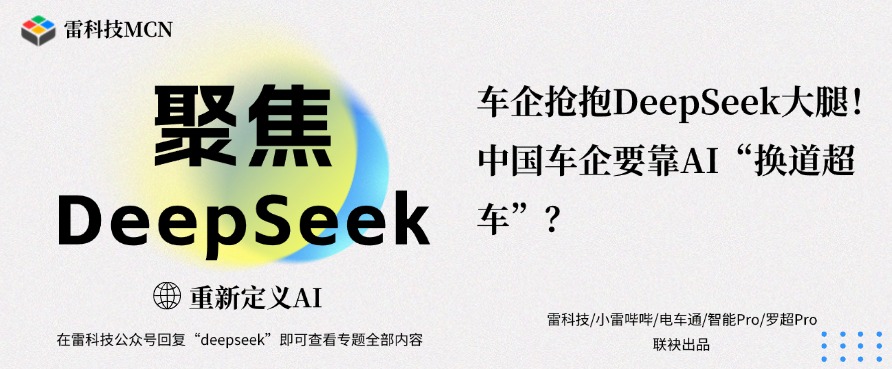
A silent battle is unfolding within the automotive cabin.
As ChatGPT revolutionizes human-computer interaction, automakers have long recognized the potential of AI large models—redefining intelligent cabin experiences from voice assistants to autonomous driving, emotional companionship to scenario-based decision-making.
In this race, DeepSeek has quietly entered the automotive arena. Within days, Geely, Lunar, and other brands have announced collaborations, with some car owners even "hand-coding" to bring the full-fledged model to their vehicles early. Behind this technological storm lies the ambition of Chinese automakers to leapfrog competitors.
DeepSeek is fundamentally changing the intelligent war among Chinese automakers. This "in-car revolution" may come faster than anticipated.
Carmakers rush to embrace DeepSeek—has the AI cabin revolution begun?
As of February 8, six automakers have officially announced their integration with DeepSeek.
On February 7, Lunar announced the completion of its deep integration with the DeepSeek model. Lunar Zhiyin will be the first mass-produced model in the industry to integrate DeepSeek. Previously, Lunar Xiaoyao Cabin had completed access and deployment of the full DeepSeek model series. Starting February 14, Lunar Zhiyin users will experience it via OTA updates, with Lunar gradually unlocking more DeepSeek capabilities in the future.
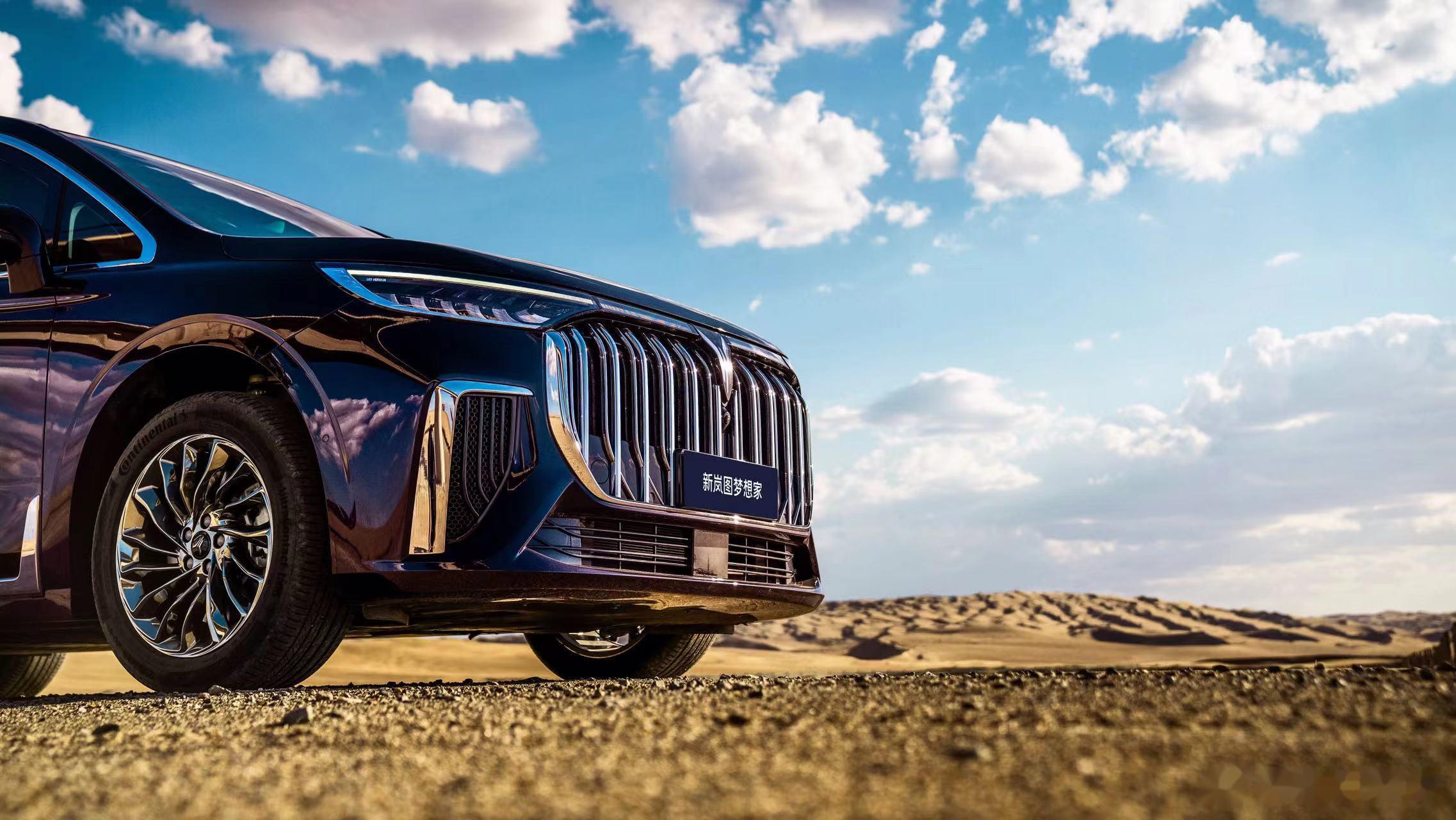
Image source: Lunar Dreamliner
On the same day, Geely Automobile announced the successful technical integration of its self-developed Xingrui large model with DeepSeek-R1. By deeply integrating DeepSeek's cognitive large model with the in-car AI system, Geely aims to address two long-standing issues in smart cars: vague intention understanding and proactive service capabilities. This innovation will provide users with a more intelligent and convenient driving experience.
The Zeekr intelligent cabin team has completed deep integration of its self-developed Kr AI large model with the DeepSeek R1 large model. The Zeekr intelligent cabin assistant AI Eva has integrated the DeepSeek R1 large model and will soon be launched.
Dongfeng Motor Corporation also announced the completion of access work for the full DeepSeek large language model series, with its independent brands—including Mengshi, Yipai, Fengshen, and Nano—to be successively equipped with these applications in the near future. The official stated that this technological breakthrough will revolutionize user-car interaction—from "passively executing commands" to "actively understanding needs," making cars "thinking" travel partners that offer a smarter driving experience.
Currently, Dongfeng Mengshi 917's intelligent cabin has completed access to the DeepSeek-R1 model, planned to be the first to receive OTA updates on models such as Mengshi 917 and Jiaolong Zhanjia before the Shanghai Auto Show in April 2025.
In addition, brands such as Great Wall, IM Motors, and Baojun have announced their access to DeepSeek. It is foreseeable that more automaker brands will successively make official announcements in the coming period.
Surprisingly, enthusiasts can no longer contain their excitement. On Xiaohongshu, NIO and Tesla owners have accessed the DeepSeek webpage through the in-car browser and directly conversed with the model using voice input.
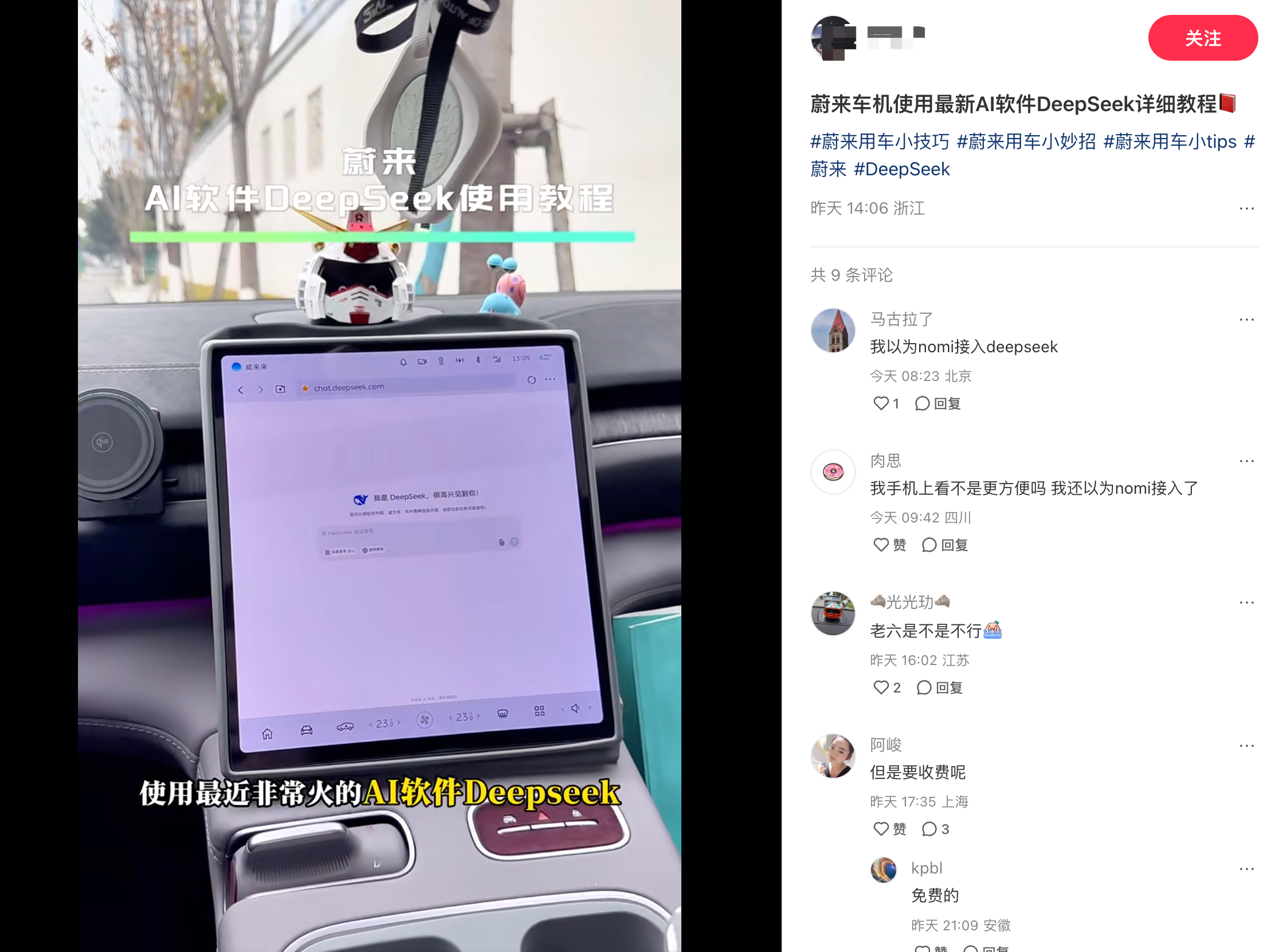
Image source: Xiaohongshu
Though limited by computing power and deployment accuracy, this phenomenon of "wild access" confirms the market's urgent expectations for AI cabins.
Breaking the deadlock with low costs, DeepSeek heralds the era of "AI-Defined Cars"
DeepSeek's entry into cars completes the final piece of the puzzle for the popularization of intelligent driving.
According to the Kaiyuan Securities report, DeepSeek-R1 costs only 16 yuan for one million token outputs, far lower than OpenAI GPT-4 (438 yuan) and GPT-4-mini (88 yuan). The cost of a million-word conversation is 16 yuan, equivalent to the price of a cup of bubble tea for a year's companionship in your car!
Low costs are sufficient to significantly accelerate the implementation of automotive intelligence. This balance of "both performance and cost savings" precisely addresses automakers' pain points amidst price wars.
For example, on the Qualcomm 8650 platform, DeepSeek can reduce the inference response time from 20 milliseconds to 19 milliseconds, with the computing power utilization rate dropping from nearly 100% to 65%. The original cost of running city NOA with 100 TOPS is approximately 7000 yuan, but with DeepSeek's intervention, it is expected to be achieved within a cost of 5000 yuan, potentially enabling the Horizon Journey 6E chip to run city NOA, significantly promoting the implementation of high-level intelligent driving.
Of course, low cost is only the initial driving force. DeepSeek's true disruptive nature lies in initiating a transformation far surpassing electrification, with AI Agent as the core.
On February 5, in his new year letter titled "Steady Progress, Marching Towards the Blue Ocean in 2025," He Xiaopeng dedicated nearly one-third of the text to discussing DeepSeek: "Around New Year's Eve, the DS large model shocked the global tech circle—not only achieving an experience comparable to OpenAI but also compressing costs to an extremely low level. In the next ten years, AI will drive changes in automobiles far surpassing electrification."
As He Xiaopeng said, from "cars + AI" to "AI-Defined Cars." AI will deeply penetrate the entire chain of research and development, manufacturing, and services. This "on-board" competition is not just about technological upgrades but also heralds the advent of the era of "AI-Defined Cars".
At the CES 2025 exhibition site, we can clearly feel that AI cars are becoming more tangible and in-depth.
For example, Geely Automobile released the "Intelligent Vehicle Full-domain AI" technology system during CES 2025. Through the AIOS scheduling engine, Geely's "Intelligent Vehicle Full-domain AI" can integrate the needs and perception data of various devices such as vehicles, mobile phones, tablets, wearable devices, smart homes, and other forms of intelligent entities.
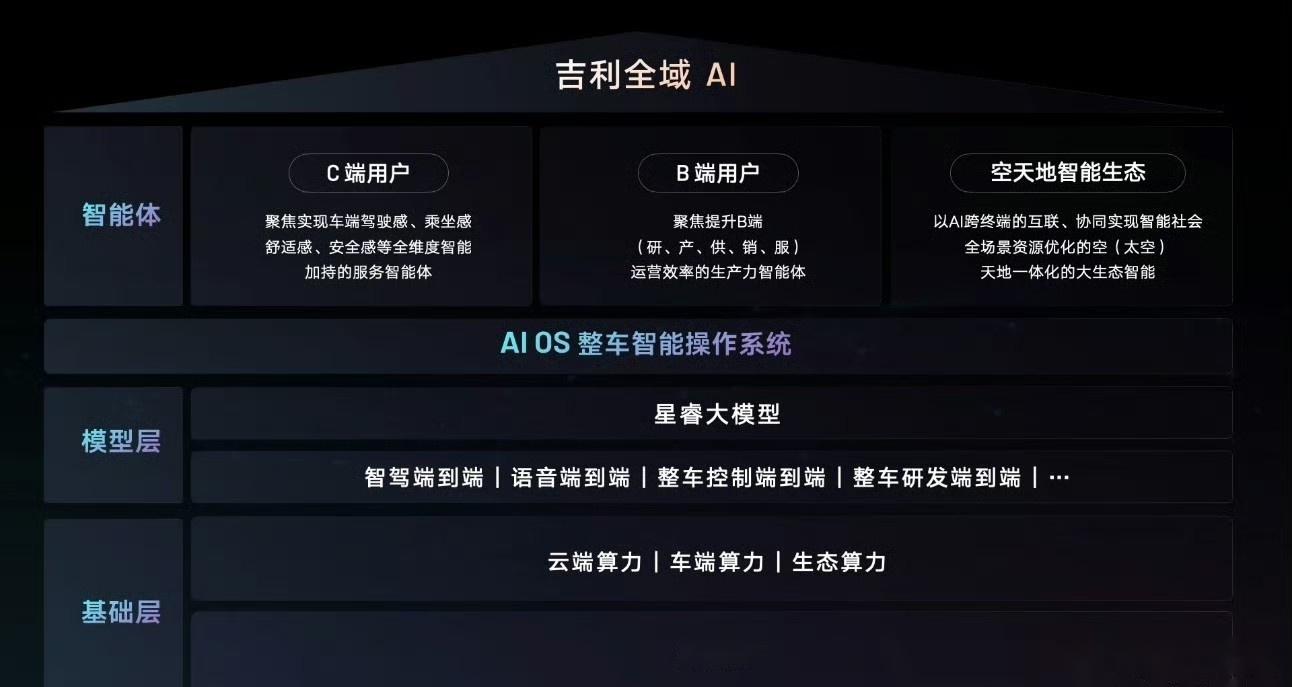
Image source: Geely Automobile
Great Wall Motor Corporation has proposed a new idea for AI development—the ASL large model of spatial language intelligent agents, marking a new stage of intelligent evolution for Great Wall Motor. By achieving comprehensive and three-dimensional information processing and intelligent decision-making, it will transform smart cars into true AI intelligent agents.
Even overseas multinational automakers, slower in intelligence, are promoting the integration of AI large models into cars. Starting from September 6, 2024, the Volkswagen Group will integrate OpenAI's ChatGPT AI chatbot service into multiple models, becoming the first mass-produced vehicle brand in the industry to come standard with ChatGPT functionality. The BMW Group, on the other hand, has chosen the Amazon Alexa large language model to create a new generation of BMW intelligent personal assistants, providing generative AI technology.
If in the past, AI cars were conceptual plays by a few leaders, now, the emergence of DeepSeek officially sounds the rallying call for marching towards AI, ushering in the 2.0 era of automotive intelligence.
From intelligent cabins to intelligent driving and then to the chassis domain, AI large models are rapidly transforming automobiles into "super intelligent agents." During this round of technological reshaping, Chinese independent automotive brands have already taken a front-row position.
Leapfrogging Competitors, AI Becomes the "New Narrative" for Domestic Smart Cars
In the future, all car companies will be AI companies.
As more automakers join the "DeepSeek circle," Chinese automakers view AI large models as the second overtaking point after the "electrification curve".
On one hand, overseas automakers are hampered by data compliance and research and development inertia, making slow progress in AI iteration. For example, though Volkswagen claims to have integrated ChatGPT, its functionality is still limited to basic question and answer, while Lunar has achieved a closed loop in the cabin decision-making chain through deep collaboration with DeepSeek.
On the other hand, China's well-developed supply chain and open-source ecosystem have become accelerators. DeepSeek's open-source nature encourages automakers and developers to co-create, while low-cost computing power solutions provided by local chip vendors such as Horizon Robotics and Black Sesame Technology have significantly lowered the threshold for "model onboarding".
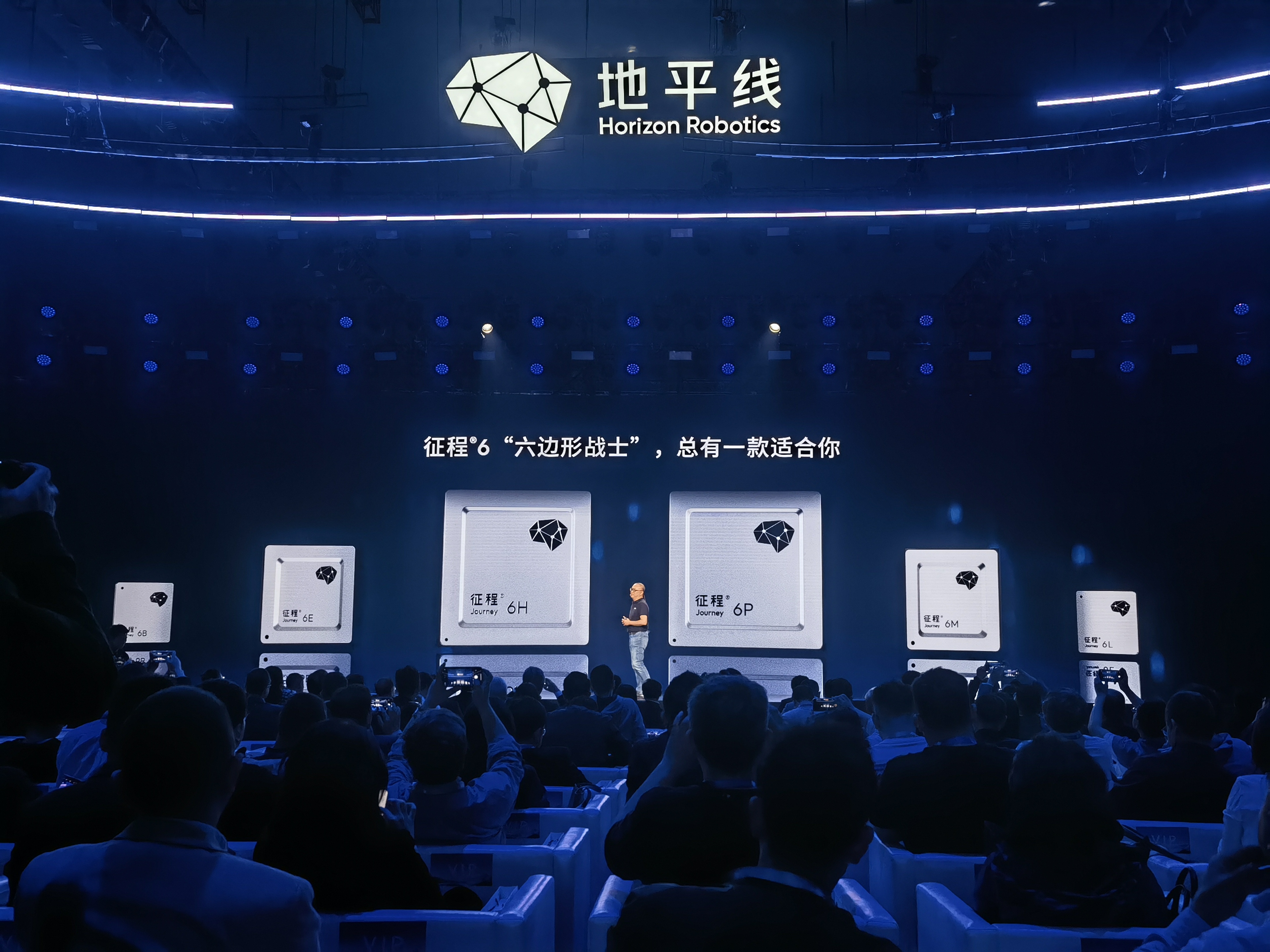
Image source: Horizon Robotics
If in the past, Tesla achieved a closed loop with millions of vehicle driving data from its FSD, far ahead of other automakers.
After DeepSeek, the landscape may not necessarily be the same. The cost of vehicle intelligence has been greatly reduced, making it accessible for any automaker to try. Musk once said that if full autonomous driving is truly achieved, its value should be five times that of the car itself. With the empowerment of large models, the timing for achieving this goal has been significantly shortened.
As Cinda Securities predicts: "DeepSeek-R1 is not only a milestone for AGI but also a fulcrum for China's automotive industry to leapfrog competitors." While global automakers are still anxious about the "electrification transformation," the Chinese contingent already holds the AI key and is heading towards the vast sea of intelligence.
From mechanical horsepower to data computing power, from driving tools to life partners, AI is redefining the form of automobiles. The "onboarding wave" of DeepSeek is not only a microcosm of technological leapfrogging but also a clarion call for Chinese automakers to export intelligent standards globally.
It is foreseeable that the intelligent cabin in 2025 will no longer be a pile of screens and buttons but a "travel companion" that understands emotions, learns, and evolves. When Lunar owners arrive at their destination through AI poetry interactions, and when Geely's in-car system proactively plans the optimal route to avoid heavy rain, this revolution sparked by DeepSeek may only be just beginning.
After all, in the dictionary of AI, there is no "ceiling" but only "the next question".
Source: Leitech





